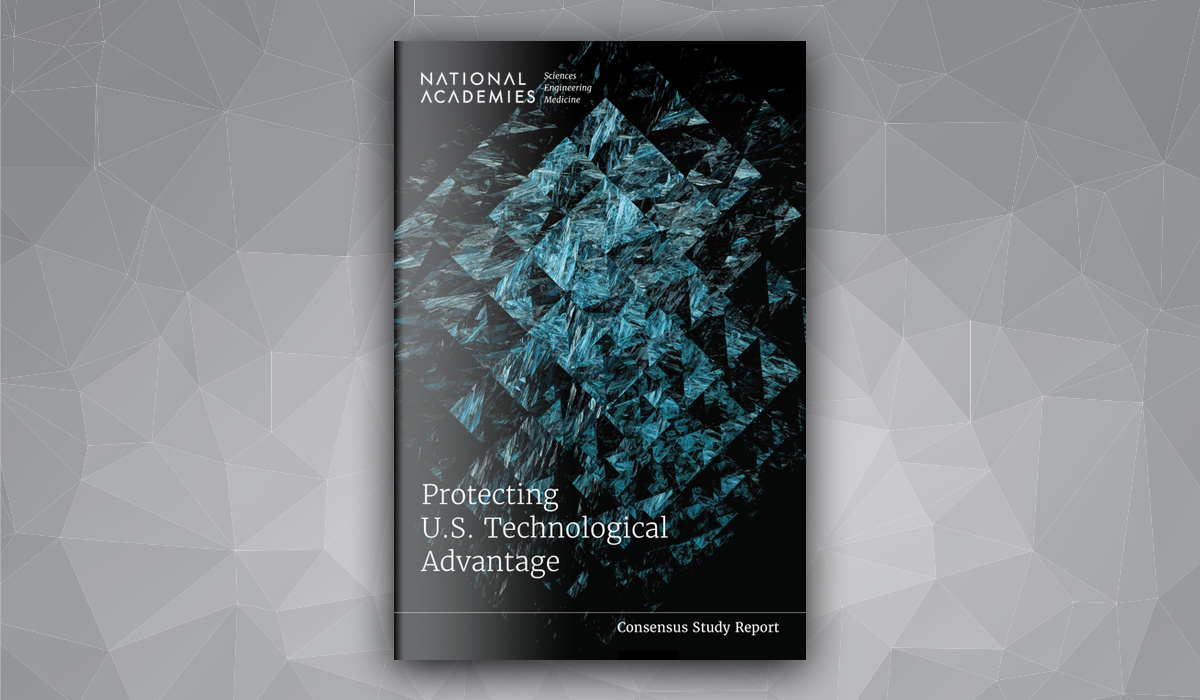In late September, the National Academies released a report on “Protecting U.S. Technological Advantage,” a collaborative effort of seven Academy boards and committees. The work was spearheaded by the Academy’s Committee on Protecting Critical Technologies for National Security in an Era of Openness and Competition, chaired by Patrick Gallagher, Chancellor of the University of Pittsburgh.
The report posits that U.S. technological competitiveness has traditionally hinged on the economic and technological dominance of our research and development system coupled with the ability to limit access to military sensitive technologies through controls.
In an effort to limit the global diffusion of U.S.-funded R&D, the U.S. research community has seen an extraordinary increase in the number and complexity of policies, processes, procedures, and requirements governing the conduct of science and technology R&D. The report suggests “That expansion, combined with the increasing array of government stakeholders exercising authority in this realm, has created a complex set of rules that limits the exchange of ideas, participation by others, and international collaboration — slowing the pace of research and making research environments less attractive to talented people.”
At the same time, these efforts to control the dissemination of technology are being undermined by the increasing dependence of military R&D on commercial technology developments and the increasing importance of highly integrated and globally shared innovation platforms, which link researchers around the world through linked networks of operating systems, telecommunications networks such as 5G, the internet, genome editing, and microelectronics fabrication technologies. They note “platforms enable rapid, massive-scale, and lower-cost development by incorporating shareable technology elements into new technology applications. They are often developed and operated by the private sector and have become an essential part of the technology ecosystem.”
Thus, the report concludes that “the assumption that the United States will continue to hold a dominant competitive position by depending primarily on its historical approach of identifying specific and narrow technology areas requiring controls or restrictions is not valid.”
Instead, the report recommends that “the United States should strive to maximize the amount of work that can be appropriately performed in an open research environment, an approach that will promote U.S. leadership in science and engineering, attract top talent, and enhance discoveries that lead to new technologies.” They suggest:
“Research, training, and teaching conducted in an open environment benefit the United States because they attract research talent, foster creative and innovative conditions for discovery, and speed the development of new ideas and technologies. At the same time, conducting this work in an open environment poses a risk that knowledge, know-how, or results may flow to adversaries as a result of the movement of either information or people. But for an innovation leader, the benefits of openness outweigh the risks for most R&D efforts because the risk of information loss is mitigated by the ability to innovate even newer technologies.”
While calling for more openness, the report also suggests that not all research-related work is appropriate for an open environment, and that participation, collaboration, the sharing of information, and the dissemination of results should be controlled on a case-by-case basis. To achieve this balance between open and closed research environments, the report outlines a series of four specific recommendations that focus on attracting and retaining the talent needed to sustain U.S. technological leadership:
- The President should issue an executive order clearly reaffirming that it is the policy of the United States that fundamental research, to the maximum extent possible, should remain unrestricted and directing the Office of Science and Technology Policy, in coordination with federal agencies, to define criteria for open and restricted research environments within 120 days of issuance of the executive order. The order would direct federal agencies to designate the appropriate environment for work under a grant or contract prior to making the award, and to maximize the amount of sponsored work that can be performed in open research environments.
- The National Science Foundation (NSF) should fund and coordinate an effort to define the elements of the U.S. innovation system that are essential to developing, attracting, and retaining the top scientific, research, engineering, and innovation talent that is necessary for U.S. leadership in technology innovation. The effort should engage other federal science agencies, universities, research institutions, educators, and research-intensive companies in this effort.
- The National Security Council, the National Science and Technology Council, and the National Economic Council should develop an interagency process for identifying and assessing threats or vulnerabilities of strategic significance to U.S. technology leadership and other national interests. For each threat, the process should include developing an associated risk management strategy and evaluation rubric for use by federal agencies in addressing the risk.
- The National Science and Technology Council, the National Security Council, and the National Economic Council should jointly develop a new policy framework for the identification of strategically important platforms and for the development of coordinated risk management strategies covering their development, control, and use.
The full report is available for review at: https://nap.nationalacademies.org/catalog/26647/protecting-us-technological-advantage
